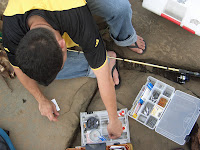
The Daiwa Emcast 5000 Fixed Spool reel.
First off as you can see the handle is large and thick. Rather than the normal thin plastic you find on most reels. The surface is non-slip so even on cold, wet nights your grip remains very firm.The reel comes with a spare spool but be careful of swapping them about on location because there are a lot of small parts that can come off and getting them back on in the dark when your cold and wet can be a real pain.The casting distance is very good and will easily cast in excess of 100yards and it can also hold a lot of line.

The Daiwa Samurai 3550 Fixed Spool reel.
As with most Daiwa products the Samurai 3550 is well built and can handle good fighting fish very well. With fish over around 2lb you will probably have to lift by hand any fish caught from a pier or cliff. It doesn't have the power to lift out the bigger fish but If you wanted a reel that is able of pulling out the bigger fish you want to be looking more towards the Daiwa Emcast series or even multipliers.
The handle is quite small and the circular design is a little awkward when wearing big gloves. Again for small fish or if you feel like a bit of a challenge with larger fish then this is a good reel to use.The casting distance is just as good as it's big brother and casts over 100 yards are easily archived.

The Daiwa Sealine sl30sh multiplier reel
It has no level wind but this is a good thing because it means your casting distances are that much further. An 18lb line on the reel with a 50lb shock leader. If you're like thinking no level wind is a pain, it isn't much more effort than having a level wind. By the end of one day using it you'll be happily reeling in an even line. By putting up with a manual wind in you'll be adding another 50 to maybe 100 yards better distance. Isn't that worth the effort? It also has a good casting brake on it which once confident can be taken right down but would advise starting with full break and slowly working down until you find the best brake-to-cast ratio without the birds nests.
With an 18lb line on you'll be able to put a little over 300 yards of line on the reel and the retrieve ratio is 6.1:1. This reel has 4 ball bearings and an anodised aluminum spool for lightness and strength.The only thing I don't like is the bite clicker is very quiet. The Daiwa Sealine SL30SH is excellent for all shore work, uptiding and a variety of downtide fishing. It's also suitable for fishing over the roughest of sea beds.


























 Princess Ariel shows off her talent!!
Princess Ariel shows off her talent!! Mr Goldfish waiting for some action!
Mr Goldfish waiting for some action!
 Catch of the evening!!
Catch of the evening!!












.jpg)
.jpg)

.jpg)
.jpg)
.jpg)

.jpg)

